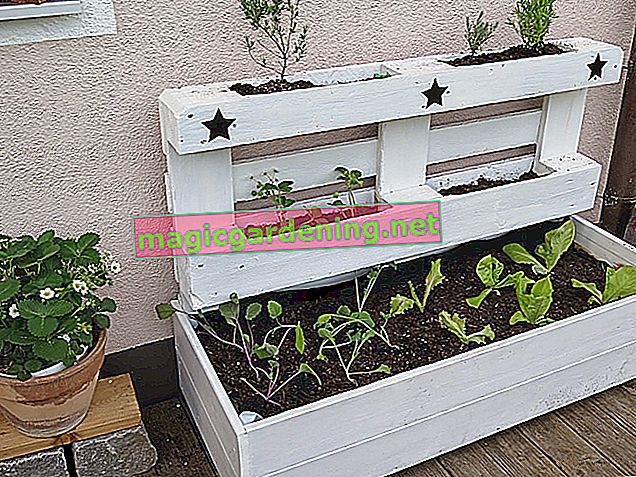
Guide to Propagation Using Cuttings - Here's How
Noble Vanda orchids and other monopodial species produce cuttings from their branching main axis. After a while, the young colony thrives with its own aerial roots, so that a separation from the mother plant is possible for a self-sufficient orchid life. Here's how to do it correctly:
- Cut cuttings from a height of 20 cm and with at least 2-3 aerial roots
- Growing pots (€ 14.90 at Amazon *) fill with a light, airy mix of peat and sphagnum
- Plant one cutting at a time and moisten it with lime-free water
also read
- Repotting orchids in seramis - these instructions show how to do it
- Repotting orchids properly - these instructions show how to do it
- Divide orchids correctly for propagation - this is how it works
In the partially shaded location with warm room temperatures, keep the substrate slightly moist for the following 1 to 2 months. The cuttings do not receive any fertilizer in this phase, so that they take extra care with the rooting. Once a vital system of strong, firm aerial roots has formed, repot the young orchids. From this point on, you care for the offspring like an adult plant.
First feed up the head cuttings - only then cut them off
The chances of success for a head cutting depend on how many aerial roots it is supplied with. It should be at least 2-3 - a larger number optimizes growth. Therefore, as the cuttings develop on their mother plant, wrap the aerial roots with moist sphagnum. This moss wrap has a vitalizing effect on the young orchid organism until it can be cut off with a sharp cut.
Propagating terrestrial orchids with cuttings - It's that easy with terrestrial orchids
As hobby gardeners, we move on more familiar territory when the propagation of a terrestrial orchid is on the agenda. Since these orchid species are rooted in the ground, they open up similar propagation variants to classic indoor plants. Using the example of the climbing vanilla orchid, the procedure is illustrated below:
- Cut off non-blooming tendrils in early summer
- These tendrils cut into cuttings with a length of 10 to 15 cm
- Defoliate each shoot in the lower half, plant in poor potting soil and support with a stick
- Moisten the substrate with lime-free water at room temperature
Under the protection of a transparent hood, keep the potting soil slightly moist with soft water. A location with bright, not full sun light conditions and temperatures around 25 degrees Celsius is ideal now. Until a fresh shoot appears on the cutting, the cover is aired daily and can then be removed. Once your pupils have completely rooted the growing container, they are repotted and from this point on they are cared for like an adult orchid.
Duplicating Orchids With Seedlings - How To Do It Right
Popular orchid species such as Calanthe, Epidendrum or Dendrobium bring us tiny daughter plants. These seedlings unexpectedly thrive on the bulbs instead of flowers, as small leaves and aerial roots sprout here. The Kindel initially require a long line of patience, because it takes several months to a year before they can be separated from the mother plant. So the increase takes the hoped-for course:
- Only cut off the seedlings when they are 15-20 cm tall and have several aerial roots
- Plant in a loose mixture of moss and peat
- Pour regularly and spray with soft water in the heated mini greenhouse (€ 6.96 at Amazon *)
A warm, humid microclimate has a beneficial effect on the growth of children. If no indoor greenhouse is available, simply put a transparent plastic bag over the nursery pot, provided with small wooden sticks as spacers. To prevent mold from forming, the greenhouse and hood are ventilated several times a day. Once the seedlings have developed into strong young orchids, they can leave the nursery.
Meticulous cleanliness is the top priority
Orchids are among the most sensitive plants for indoor culture. This is even more true for cuttings and seedlings. Therefore, please only use cutting tools that have been carefully cleaned and disinfected with high-percentage alcohol. The scalpel has proven itself excellently in practice to separate the offshoots and children from the mother plant. The smoother the cut, the lower the risk of disease and pest infestation.
This also includes the fact that the substrate used in the propagation should be sterilized beforehand. For this purpose, fill the potting soil in a heat-resistant bowl and loosely cover it with a lid. In the oven at 150 degrees top and bottom heat, all fungal spores, viruses and bacteria that may be in it are destroyed after 20 to 30 minutes.
Tips
Some of the most beautiful orchid species allow the most gentle and simplest form of propagation. Popular species, such as the Cymbidium, produce numerous pseudobulbs. If an orchid has at least 8 bulbs, these can be pulled apart with the hands in connection with repotting in the spring into segments with 4 bulbs each and placed in their own culture pots with fresh substrate.








